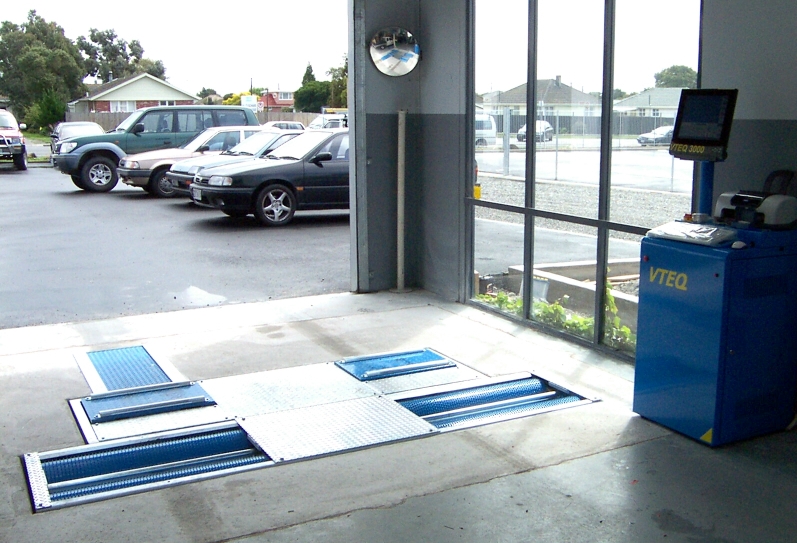
VTEQ Under car testing equipment.
Article No.25 Page 2/2
...Brake efficiency
What are the results of brake force on brake efficiency? Brake efficiency is after all the data that we need for our WoF. The brake efficiency is simplified the relation between the vehicle's weight and total vehicle brake force.
The legal minimum brake efficiency for service brakes is 50%.
Lets play with this given fact and the above example. To make things easy I will only focus on the single axle with the (static) weight of 2000 Kg's.
If on an axle with a weight of 2000 Kg's a brake force is measured of 5 KN per wheel the efficiency is 5 (KN) x 2 (wheels) = 10 KN / 10 (Kg's) = 1000Kg's
1000 Kg's brake force on an axle of 2000 Kg's weight returns an efficiency of 50%.
With multiple axles the whole calculation stay's the same; the total vehicle weight divided by the total brake force.
Weight measurement
To me as an engineer it seems an absolute must to have a weighing system on a serious brake tester.
AECS has only one analogue entry level VTEQ 6KN (per wheel) machine available without weight measuring system, the VTEQ 2000 (ready to use, installed) for $12,500 plus GST.
All other model test lanes and brake testers have a weighing system, remote control and 4WD test ability as standard fitted.
Lets look at the effect of an incorrectly guessed weight on the brake efficiency.
Lets use the 8.5 KN of brake force measured with the 0.85 friction coefficient rollers.
Guessing weight
Look at the 2000 Kg axle and guess a weight of 1800 Kg's, this results in an brake efficiency of 94.4 % (!)
Look at the axle and guess a weight at 2200 Kg's, the result is 77.27% brake efficiency.
Needless to say that a wrongly calibrated machine (weight and brake force!) have the same grossly faulty readings as result.
Can you accurately guess the weight of an axle or whole vehicle? We are talking about a safety test here!
Than to top it all off I was present during a test on a brake tester where a vehicle had a 104% efficient front axle!!! That is impossible, yet the operator of this reputable company thought nothing of it. Obviously this company had a double problem, the equipment was not calibrated properly and the training of the operator fell awfully short.
LTSA
A perfect initiative was started by the LTSA late 2002 to regulate and control those matters. It is my understanding that currently no technical requirements for roller brake testers exists, nor for the calibration of this equipment. The LTSA is working hard to get this obvious safety issue out of the way. An initiative that both AECS and VTEQ are welcoming with open arms, as their equipment is used in many countries around the world with in some the most stringent safety laws on the planet.
Nice
Some of the features that you will have with a digital (computer controlled) machine are that a brake ovality test and residual brake force test are standard on all axles including park brake. We all know that a pulling car does not always have misaligned wheels. The reported workshop sales as a result of those two features are tremendous.
4WD
The VTEQ machines come all (except the entry type) with 4WD/AWD testability standard. The machine will start both wheels at the same time with one rolling in the reverse direction to keep the drive shaft stationary. Only the forward rotating wheel is being tested. The next cycle the rollers are reversed and the other wheel on the same axle is being tested. Both results are set off against each other to determine straight braking and to calculate axle efficiency.

VTEQ test lane installed inground at Peter Thompson Tyre & Auto Service in Christchurch.
VTEQ, Available in any colour.
For AECS:
H.P. Leijen
(trainer/research)
Web: www.aecs.net
E-Mail: hpleijen@aecs.net
Ph 06 8749 077

